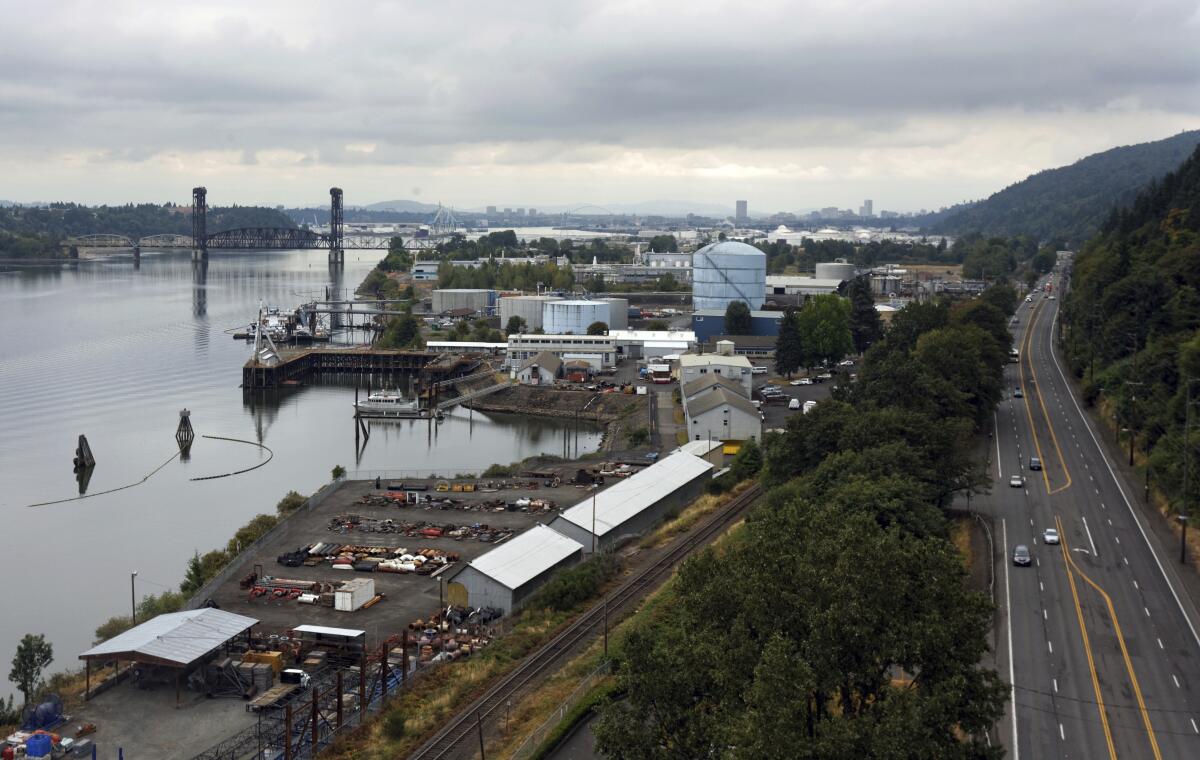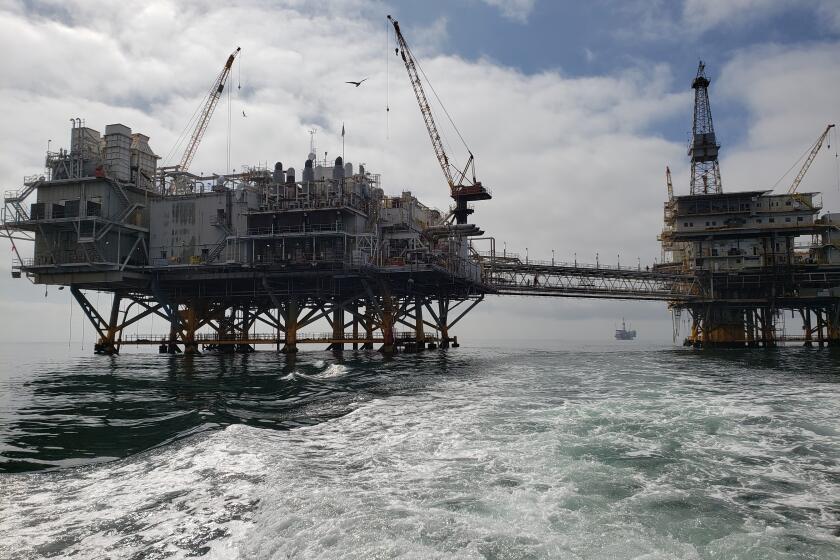Oregon bill tackles megaquake nightmare at fuel storage site

- Share via
Picture this scenario: A river on fire with millions of gallons of spilled oil, jet fuel and gasoline. An environmental disaster ranking with the worst in America. No fuel for a state trying to recover from a major earthquake.
Scientists say Oregon faces this potential nightmare unless work is done to fortify its main fuel storage facility against a major earthquake, which will come sooner or later.
More than 90% of the state’s liquid fuels are stored at the Critical Energy Infrastructure Hub, along a 6-mile stretch of the Willamette River in northwest Portland.
This week, Oregon lawmakers began taking steps to compel the owners and operators of the facility’s aging storage tanks to make them earthquake resistant.
A new report commissioned by the city of Portland and Multnomah County noted the hub is built on soils subject to liquefaction in an earthquake, meaning the water-saturated sediment would temporarily lose strength and act as a fluid.
The industrial area contains 46 large above-ground fuel tanks, a liquefied natural gas storage facility and pipelines, according to a state report. Some fuel tanks are more than 100 years old, and most were built at least 50 years ago.
The study estimated that a major earthquake along the Cascadia subduction zone would cause 95 million to 194 million gallons of fuels to gush from the tanks. Such a spill would flow from the Willamette River into the nearby Columbia River and, unless it is contained, would reach the Pacific Ocean, about 100 miles to the northwest.
The predicted damage is on a par with the greatest environmental disaster in U.S. history, when BP’s Deepwater Horizon drilling rig exploded in 2010, spilling at least 134 million gallons of oil into the Gulf of Mexico.
A large earthquake could cause the spillway gates of Oregon’s Detroit Dam to buckle, resulting ‘in a potentially catastrophic flood,’ officials say.
“The fuel releases are likely to cause explosions and fires,” the Oregon researchers wrote. “If the fire spreads to other properties there are very large threats to human life, safety, physical structures and natural resources.”
California is known for earthquakes, especially along the San Andreas fault. But experts predict one of the world’s biggest earthquakes could occur any day along the Cascadia subduction zone, which runs from offshore Northern California, Oregon and Washington state to Canada. The last time a major Cascadia earthquake occurred was in 1700, with an estimated magnitude 9 quake.
Oregon officials recognize the threat, and have taken steps to mitigate it.
Oil industry experts say the U.S. Bureau of Safety and Environmental Enforcement has long failed to adequately monitor offshore drilling operations.
Great Oregon ShakeOut Day is held annually to encourage Oregonians to learn how to react to an earthquake. Gov. Kate Brown frequently reminds people to maintain emergency kits with at least two weeks’ worth of food, water and other necessities. Tsunami-zone warning signs dot coastal highways.
In 1995, the Legislature banned construction of certain emergency and other public facilities in tsunami inundation zones. But it repealed the measure in 2019 after coastal legislators said that without new emergency services buildings, coastal residents and businesses wouldn’t be able to get property insurance, which would cause property values to fall.
Oregon joined an early-warning system last year operated by the U.S. Geological Survey. It uses seismographic sensors to detect significant earthquakes quickly so alerts reach smartphones and people can seek cover. Washington state and California also use the system.
Seismologist Lucy Jones, journalists Rong-Gong Lin and Patt Morrison of the L.A. Times, and journalists Jacob Margolis and Austin Cross of KPCC/LAist discuss earthquake safety and resilience in California. Here are five things to remember when preparing for the Big One.
An earthquake of at least magnitude 7 has a 37% chance of occurring off the Oregon coast in the next 50 years, according to Chris Goldfinger, an earthquake expert at Oregon State University. A magnitude 9 quake has a 10% to 15% chance of occurring in that period, he said. The largest quake ever recorded was magnitude 9.5, hitting southern Chile in 1960.
“We’re living with a ticking time bomb,” state Sen. Michael Dembrow of Portland said Monday during the Senate Committee on Energy and Environment‘s public hearing on the measure.
Dembrow, a chief sponsor of the bill, said every time he drives by the storage tanks, he has a “nightmare vision that the earthquake strikes, as we know it will, and we elected officials are left having to ask ourselves: Why did we ignore the warnings?”
“If that occurs, how do we live with ourselves?” he asked fellow lawmakers. Two dozen others have joined him in sponsoring the bill.
Leaders of the American Society of Civil Engineers’ Oregon branch testified that it’s critically important that the facility be made seismically resilient. They noted that after a major earthquake, fuel will be needed to power generators, equipment and vehicles for rescue and emergency personnel.
Whether you’re on a fixed income or just trying to save a few dollars, there are ways everyone can prepare for disaster on a budget. Here’s a checklist and tips on insurance, supplies and more.
All of the jet fuel for Portland International Airport is stored at the Critical Energy Infrastructure Hub. Without it, planes bringing aid to Oregon would be unable to refuel.
Mike Harryman, appointed by the governor as Oregon’s first state resilience officer and tasked with preparing for a Cascadia earthquake, said Oregon will feel three punches: from the quake itself, the subsequent tsunami and “the disaster” at the fuel hub.
“To date, I’m unaware that any seismic mitigation has been started at the site by any of the owners and/or operators,” he told the hearing.
The bill requires owners or operators of bulk oil and liquid fuel terminals to conduct seismic vulnerability assessments and submit them by June 1, 2024, to the Oregon Department of Environmental Quality for review. The owners and operators would then implement a department-approved seismic risk plan.
“How they do the work and on what timetable isn’t yet clear,” Dembrow said in an email.
Jessica Spiegel, of the Western States Petroleum Assn., a nonprofit that represents companies involved in the industry in five states including Oregon, noted that the bill entails large fees but that federal funds may be available to mitigate them.
She said that as fees are established, “some understanding of business needs in the state” should be taken into account.
More to Read
Sign up for Essential California
The most important California stories and recommendations in your inbox every morning.
You may occasionally receive promotional content from the Los Angeles Times.

















